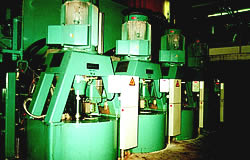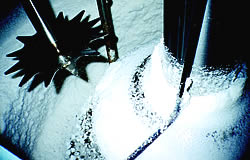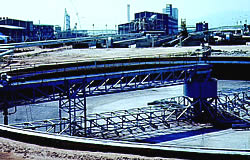Centrifugation
 After cooling of massecuite in a stirring vessel, massecuite is led into the centrifugal machines revolving at 1.300 r.p.m. Through the influence of the centrifugal force, the white crystal sugar is separated from the surrounding dirt syrup and is laid down on the walls of the centrifugal basket. After a hot water washing the white sugar dries and it is stored. The syrup undergoes two new consecutive crystallizations and centrifugations. The sugar resulting remelts and is led to feed the apparatuses of the first stage of crystallization.
After cooling of massecuite in a stirring vessel, massecuite is led into the centrifugal machines revolving at 1.300 r.p.m. Through the influence of the centrifugal force, the white crystal sugar is separated from the surrounding dirt syrup and is laid down on the walls of the centrifugal basket. After a hot water washing the white sugar dries and it is stored. The syrup undergoes two new consecutive crystallizations and centrifugations. The sugar resulting remelts and is led to feed the apparatuses of the first stage of crystallization.
 The final syrup of centrifugation, the molasses, contains all those foreign substances non sugars. Which were not removed from the stage of juice purification, and binds one part of sugar. The molasses is used as a raw material to produce spirit, bakery yeast and fodder. Sugar is stored in warehouse in paper-bags or in bulk in sugar silos.
The final syrup of centrifugation, the molasses, contains all those foreign substances non sugars. Which were not removed from the stage of juice purification, and binds one part of sugar. The molasses is used as a raw material to produce spirit, bakery yeast and fodder. Sugar is stored in warehouse in paper-bags or in bulk in sugar silos.
Energy and Heat
The sugar factories apply the cogeneration of steam and electricity. The factories have steamboilers with a steam pressure 26-45 bar, temperature 380o- 450oC. The steam passes through a counter-pressure turbine where electric energy is produced to cover the needs of the factory. The required power for a sugar factory is 2,4-3,6 kWh /100 kg beets. The exhaust steam coming from the turbine under pressure 2-3 bar covers the thermal needs of the factory. It is introduced into the evaporation station, 7 steam-boilers yielding a power of 29MW are installed tn the 3 H.S.I. Factories. The steam consumption is 25-35 kg/100 kg beets.
Environmental protection
 The factories use enormous quantities of water, about 20 times as much the quantity of the beets, for transport, washing of the beets, and for water cooling, but it should be noted that through recirculation, purification and cooling respectively, the need for primary water was seriously reduced to a percentage less than 1:1. Nowadays al H.S.I. factories have circular tanks with a diameter 50-70 meters for setting the earthen soil mixtures coming with the beets and moving away during transport and washing with water. The thick mud is then taken to outdoor tanks (lagoons) of anaerobic and aerobic processing so that the final liquid wastes may have a small specific load (20-70 g/m3 BOD5) and may be appropriate for irrigation or direct dispose off into a natural receptor. These lagoons in some factories evolve into natural habitats where families of birds (sea- gulls, ducks e.t.c.) are gathered. The mud of juice purification is mainly calcium carbonate and it is used for the improvement of acid soils.
The factories use enormous quantities of water, about 20 times as much the quantity of the beets, for transport, washing of the beets, and for water cooling, but it should be noted that through recirculation, purification and cooling respectively, the need for primary water was seriously reduced to a percentage less than 1:1. Nowadays al H.S.I. factories have circular tanks with a diameter 50-70 meters for setting the earthen soil mixtures coming with the beets and moving away during transport and washing with water. The thick mud is then taken to outdoor tanks (lagoons) of anaerobic and aerobic processing so that the final liquid wastes may have a small specific load (20-70 g/m3 BOD5) and may be appropriate for irrigation or direct dispose off into a natural receptor. These lagoons in some factories evolve into natural habitats where families of birds (sea- gulls, ducks e.t.c.) are gathered. The mud of juice purification is mainly calcium carbonate and it is used for the improvement of acid soils.
 |
|
|
 After cooling of massecuite in a stirring vessel, massecuite is led into the centrifugal machines revolving at 1.300 r.p.m. Through the influence of the centrifugal force, the white crystal sugar is separated from the surrounding dirt syrup and is laid down on the walls of the centrifugal basket. After a hot water washing the white sugar dries and it is stored. The syrup undergoes two new consecutive crystallizations and centrifugations. The sugar resulting remelts and is led to feed the apparatuses of the first stage of crystallization.
After cooling of massecuite in a stirring vessel, massecuite is led into the centrifugal machines revolving at 1.300 r.p.m. Through the influence of the centrifugal force, the white crystal sugar is separated from the surrounding dirt syrup and is laid down on the walls of the centrifugal basket. After a hot water washing the white sugar dries and it is stored. The syrup undergoes two new consecutive crystallizations and centrifugations. The sugar resulting remelts and is led to feed the apparatuses of the first stage of crystallization.  The final syrup of centrifugation, the molasses, contains all those foreign substances non sugars. Which were not removed from the stage of juice purification, and binds one part of sugar. The molasses is used as a raw material to produce spirit, bakery yeast and fodder. Sugar is stored in warehouse in paper-bags or in bulk in sugar silos.
The final syrup of centrifugation, the molasses, contains all those foreign substances non sugars. Which were not removed from the stage of juice purification, and binds one part of sugar. The molasses is used as a raw material to produce spirit, bakery yeast and fodder. Sugar is stored in warehouse in paper-bags or in bulk in sugar silos. The factories use enormous quantities of water, about 20 times as much the quantity of the beets, for transport, washing of the beets, and for water cooling, but it should be noted that through recirculation, purification and cooling respectively, the need for primary water was seriously reduced to a percentage less than 1:1. Nowadays al H.S.I. factories have circular tanks with a diameter 50-70 meters for setting the earthen soil mixtures coming with the beets and moving away during transport and washing with water. The thick mud is then taken to outdoor tanks (lagoons) of anaerobic and aerobic processing so that the final liquid wastes may have a small specific load (20-70 g/m3 BOD5) and may be appropriate for irrigation or direct dispose off into a natural receptor. These lagoons in some factories evolve into natural habitats where families of birds (sea- gulls, ducks e.t.c.) are gathered. The mud of juice purification is mainly calcium carbonate and it is used for the improvement of acid soils.
The factories use enormous quantities of water, about 20 times as much the quantity of the beets, for transport, washing of the beets, and for water cooling, but it should be noted that through recirculation, purification and cooling respectively, the need for primary water was seriously reduced to a percentage less than 1:1. Nowadays al H.S.I. factories have circular tanks with a diameter 50-70 meters for setting the earthen soil mixtures coming with the beets and moving away during transport and washing with water. The thick mud is then taken to outdoor tanks (lagoons) of anaerobic and aerobic processing so that the final liquid wastes may have a small specific load (20-70 g/m3 BOD5) and may be appropriate for irrigation or direct dispose off into a natural receptor. These lagoons in some factories evolve into natural habitats where families of birds (sea- gulls, ducks e.t.c.) are gathered. The mud of juice purification is mainly calcium carbonate and it is used for the improvement of acid soils.